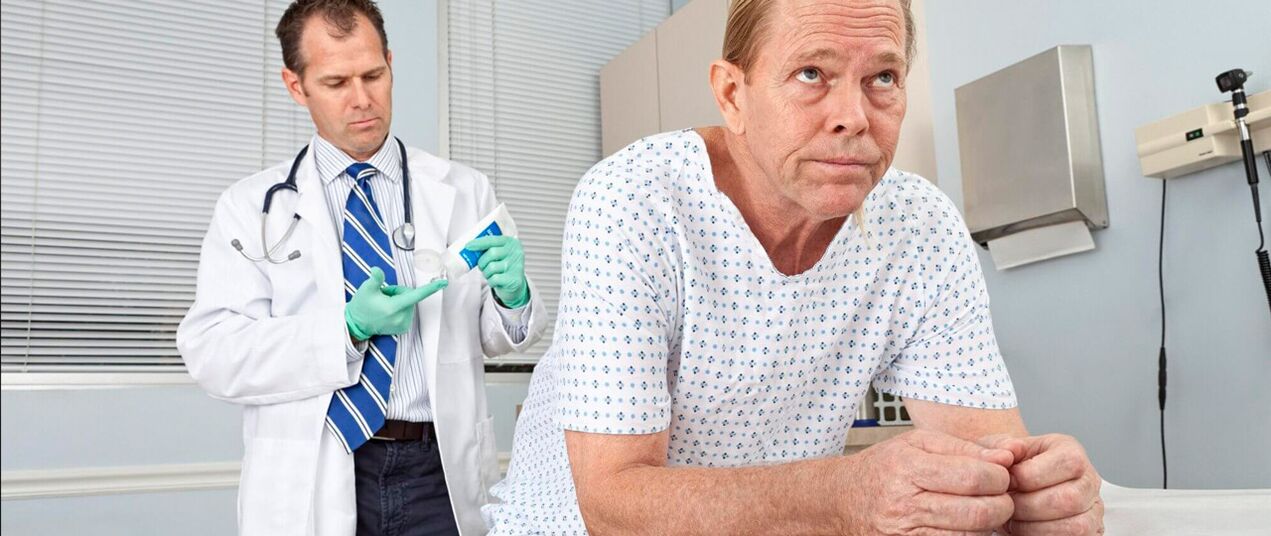
About half of male patients visiting the urologist suffer from chronic prostatitis. Problems caused by a specific pathology worsen the quality of life, lead to depression and mental disorders.However, a clear understanding of the function of the prostate gland and the mechanism of development of inflammation allows us to properly determine the symptoms and to cure the disease in a timely manner.
The importance of the term "prostatitis"
This term is customary to understand the development of the inflammatory process in the tissues of the prostate gland.Because it is only present in the male body, the disease is common in this category of the population.Its main function is the development of a specific fluid that participates in the following processes:
- forms and maintains a certain environment in the urethra;
- Dilutes semen;
- provides the viability of semen;
- Protects the geniopolous system from infection.
Under the influence of a number of factors, the secretion of the secret slows down, which in itself becomes a violation.The cells of the prostate epithelium deserve periodically, but due to congestion they are not separated but accumulated, forming microlitis - small pebbles.Covered by mucus, they clog the glands, leading to the formation of small abscesses.During this period, the body still continues to function normally, external negative manifestations are absent.
The progression of the process (accumulation of dense formations, an increase in concentration of purulent content) leads to an increase in the organ and compression of the ureter, blood vessels and nerve endings.This is one of the causes of the disease.
Symptoms of the disease based on patient's complaints
Already at the stage described, the first signs that one cannot notice are manifested.Based on these changes, you can independently identify the development of inflammation at home.Of course, such a diagnosis is indicative, but it is considered a serious reason to contact a specialist.
Only -diagnosis at home
What are the first signs of prostatitis in men?
Difficult urine outflow.The compression of the urethral canal is increased in size from the tissues of the prostate leads to its narrowing and as a result, to prevent urine from leaking.The patient should implement a certain effort during urination.
A long output of urine.Calls to empty the bladder are becoming more and more frequent.At first, it happens at night, later during the day.Looking at it in an extra cup of tea, the man continues to ignore the violations.
Pain in the lower abdomen.The symptom is a consequence of the accumulation of microlitis.Feelings become unpleasant and lubricate, pull or burst painful.By the evening or after exercise, their increase may occur.
Erection and ejaculation disorders.The syndrome occurs against the background of stagnant phenomena and rarely occurs.Driving this with fatigue and stress, the patient also ignores this sign.
Often the patient complains of a general worsening of the condition, fever, which is also a sign of a developing process.
The first signs of prostatitis in men require treatment, otherwise the process will go into prolonged form.
Symptoms of acute inflammation
The insidiousness of prostatitis lies in the fact that without characteristic manifestations at the beginning, it begins a sharp and rapid development, but then quickly chronic.

In order not to miss the moment and start treatment on time, a clear idea of the symptoms of acute form is needed.
- Fever, chills.
- Increasing body temperature to critical values (39 ° C).
- Severe pain in the perineum, lumbar and inguinal region.
- Urination disorders - frequent and fake urges, difficult urine outflow or temporary termination.
- The utxication is pronounced - headache, weakness, joint pain and muscles, tachycardia.
- Transparent or whitish discharge from the urethra.
The study of the rectal soil becomes impossible due to the formation of pain syndrome.In addition, it is contraindicated because there may be a spread (spread) of infection with blood flow and the development of sepsis.
Manifestations of chronic relapse
In slow form, pathological processes of different types of disease can occur.Based on patients' complaints and diagnostic data, experts distinguish the following signs of prostatitis for chronic general order:
- Discomfort, moderate pain in the crotch, radiating to the sacrum, lower back, scrotum, weakness and pain in the body.
- Weight and rubber in the urinary canal during intercourse or urination.The presence of disposal of pus from the urethra.
- Frequent urination, accompanied by a feeling of incomplete emptying at the end of the process.
- The inability to fertilization associated with the lack of semen mobility, their agglutination, or an increase in the acidity of the secret.
- Ejaculation disruption (premature or, conversely, prolonged), pain or deleted orgasm sensations.

Types of illness and concomitant signs
Urologists distinguish several stages of chronic inflammation of the gland, each of which corresponds to certain manifestations.
A characteristic characteristic of all types is a syndrome of moderate pelvic pain.
| Prostatitis | Symptoms |
|---|---|
| Chronic bacterial | Dysuria, premature ejaculation |
| Pedal pain syndrome | Lack of other manifestations except pain |
| Inflammatory | Expressed problems with urination, the discomfort in the genitals |
| Stagnant | In some cases, Dysuria, discomfort |
| Asymptomatic | There are no clinical manifestations |
Professional diagnostics
The doctor may already determine the presence of prostate inflammation during the first visit of a man.However, it is possible to determine the etiology, stage and complexity only with the help of instrumental and laboratory tests.
A primary examination of the doctor
The history of the anamnesis is a patient examination and the analysis of external symptoms is one of the important stages of diagnosis.During the conversation, the doctor determines the presence of clinical signs and the reason for the development of the pathological process.Here the lifestyle of the patient, bad habits, the use of contraceptive methods and the presence of a sexual partner are important.At the same time, he draws attention to the likelihood of existing diseases of close relatives and hereditary predisposition.
The next step is a rectal examination of the prostate gland. Palpation is performed to determine such parameters as:
Palpation is performed to determine such parameters as:
- the size of the organ;
- structure and contours;
- the presence of seals;
- pain.
Laboratory tests
The next step is to have analyzes.This category is quite extensive, so only a urologist determines the need for each of them.
Oam khratestizes the general condition of the urine system. Increased content of red blood cells, leukocytes and proteins, as well as the presence of mucus and other impurities, shows an extensive course of the inflammatory process.
Urethral spreading is a painful and unpleasant procedure, which, however, allows you to determine the presence of infection and identify its variety.
Bacteriological sowing of urine allows you to identify the location of the lesion, a variety of infection and the type of pathogen.
Cytological analysis of semen is performed to determine its physicochemical properties, mobility, activity and concentration of sperm, as well as the level of the dog.The biomaterial fence is performed directly in the laboratory after prostate massage.
The condition of the procedure is sexual abstinence during the day.In the case of suspicion of chronic treatment, this type of testing is systematically performed.
Symptoms found using instrumental diagnostic methods
Hardware methods are recognized as the most effective, which is due to the obtaining accurate and detailed information about the physical characteristics of the prostate gland and the alleged pathological changes in its tissues.They greatly facilitate the work of doctors.
Of the whole variety of species, as a rule, only ultrasound is performed and other methods are used if additional results are necessary.
The ultrasound is performed to visualize the gland and determine its general condition, size, consistency.The transrectal method is considered to be more information - Truzi.A special sensor is introduced into the rectum that allows you to determine what the organ looks like, to identify tumors, adhesions, calculations, calcina, cystic formations and other pathological abnormalities.
The MRI is prescribed to determine the type of prostatitis and more in clarifying the mandatory achievements of the results obtained, especially if some details remain unclear.
Urooflometry determines the speed of urine current, the time to achieve its maximum value, the volume of urine.It is performed using a special device.
A thin probe cystoscopy allows to assess the condition of the bladder and urethra channel, as well as to identify the alleged and existing pathological changes.
The biopsy is carried out in case of suspicion of the oncological nature of the disease to rule out.
The dangers of the asymptomatic course of the disease
Prostatitis, which has no symptoms, develops in patients of the older age group.

The reasons for its appearance are:
- frequent hypothermia;
- constipation and hypodynamia;
- weakened immunity;
- reducing sexual activity;
- The presence of chronic pathologies.
The provocative factors are:
- Age of a man;
- Reduction of hormone production;
- Weakening of prostate protective functions
- Degenerative processes in their tissues.
The lack of treatment due to the inability to detect the disease in a timely manner leads to such consequences:
- Permanent erectile dysfunction;
- Prostate tissue fibrosis;
- development of renal and liver failure;
- urolithiasis;
- Benign hyperplasia of the prostate gland, adenoma, cancer.
Stunned search for a doctor: complications
The risk of prostatitis lies in its rapid transition to chronic form with oiled symptoms and the lack of a clinical picture, pronounced as in an acute course.
This form may not manifest for a long period of time, leading to irreversible processes in the tissues of the gland and various types of complications:
- vesiculitis, posterior urethritis;
- Prostate abscess;
- Sclerosis of the gland tissue and obstruction of the erynic ducts;
- polycystic formations;
- Development of a calculation form;
- impotence and infertility, concept problems;
- Pathologies of the urinary system - cystitis, pyelonephritis, urolithiasis;
- Neuro-psychogenic disorders of-Apathy, prolonged depression, reduction of self-esteem.
Ways to relieve patient's condition
The characteristics of the choice of therapeutic tactics depend on the type of disease, the form of origin, the characteristics of the leakage.
Symptomatic
The acute manifestations of the disease are extremely painful for the patient.Therefore, the priority task is to remove them.Drug treatment is used for this.In prostatitis, drugs are prescribed in men depending on the severe symptoms:
- Antibacterial drugs to eliminate pathogen.
- Diuretics are medicines to stabilize the bladder function to improve urine leakage.
- Analgesics - to eliminate pain in the head, joints and muscles.
- Antizingmodics and alpha-1-adrenal ships-for relaxing smooth muscles.
The effective dose form is considered to be rectal suppositories.Candles are used to relieve acute symptoms:
- With an antibiotic that eliminates painful cramps and fights infectious manifestations.
- With NSAIDs, equalizing inflammatory processes.
- Analgesic with analgesic that improves blood microcirculation and restores the normal state of the prostate.
Eliminating the cause of inflammation
After stopping the acute symptoms, it is necessary to initiate therapy for the basic manifestations.Treatment in this case is aimed at eliminating the infection and recovery of blood circulation.The following drug groups are used for these purposes:
- antibiotics in tablets;
- anti -inflammatory drugs;
- immunomodulators;
- Phytopreparations.
If acute manifestations are preserved but signs of prostatitis are preserved in men, the patient continues to treat physiotherapy, traditional medicine (pumpkin seeds, ginger and other medicines), alternative methods (treatment with leeches, bee bakers, manual therapy).A positive result is often achieved only after an appropriate power adjustment.
Prevention of primary prostatitis and symptoms of exacerbation of chronic form
Modern medicine has successfully coped with the elimination of prostatitis, even despite the long period of treatment.
For men who have transferred an acute form or barely recover from chronic current, it is important to observe preventive measures:
- Changing Life Change:
- regular walks;
- Active sports;
- Refusing bad habits.
- Restore normal sexual behavior:
- the choice of a reliable partner;
- rejection of random relationships;
- Regular sexual relations;
- Protective sexual contact.
- Compliance with a diet:
- rejection of fat, fried, spicy foods;
- The use of healthy and natural products.
- Preventive examination by a doctor:
- Regular - once every six months - exams;
- undergoing a course of maintenance therapy;
- Performing gymnastic exercises.
In modern living conditions, inflammation of the prostate gland is not a sentence.Despite the weight and complexity of the current, different clinical species, the disease can be perfectly treated.However, in order to avoid dangerous consequences and develop serious complications, you need to contact the specialists in a timely manner.And you need to know all the characteristics of the signs and symptoms of prostatitis.























